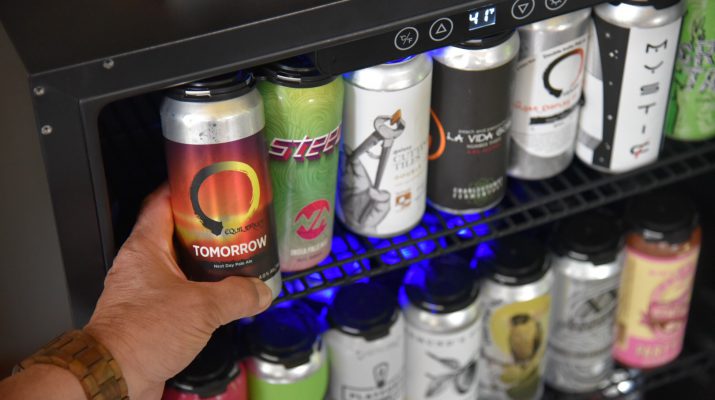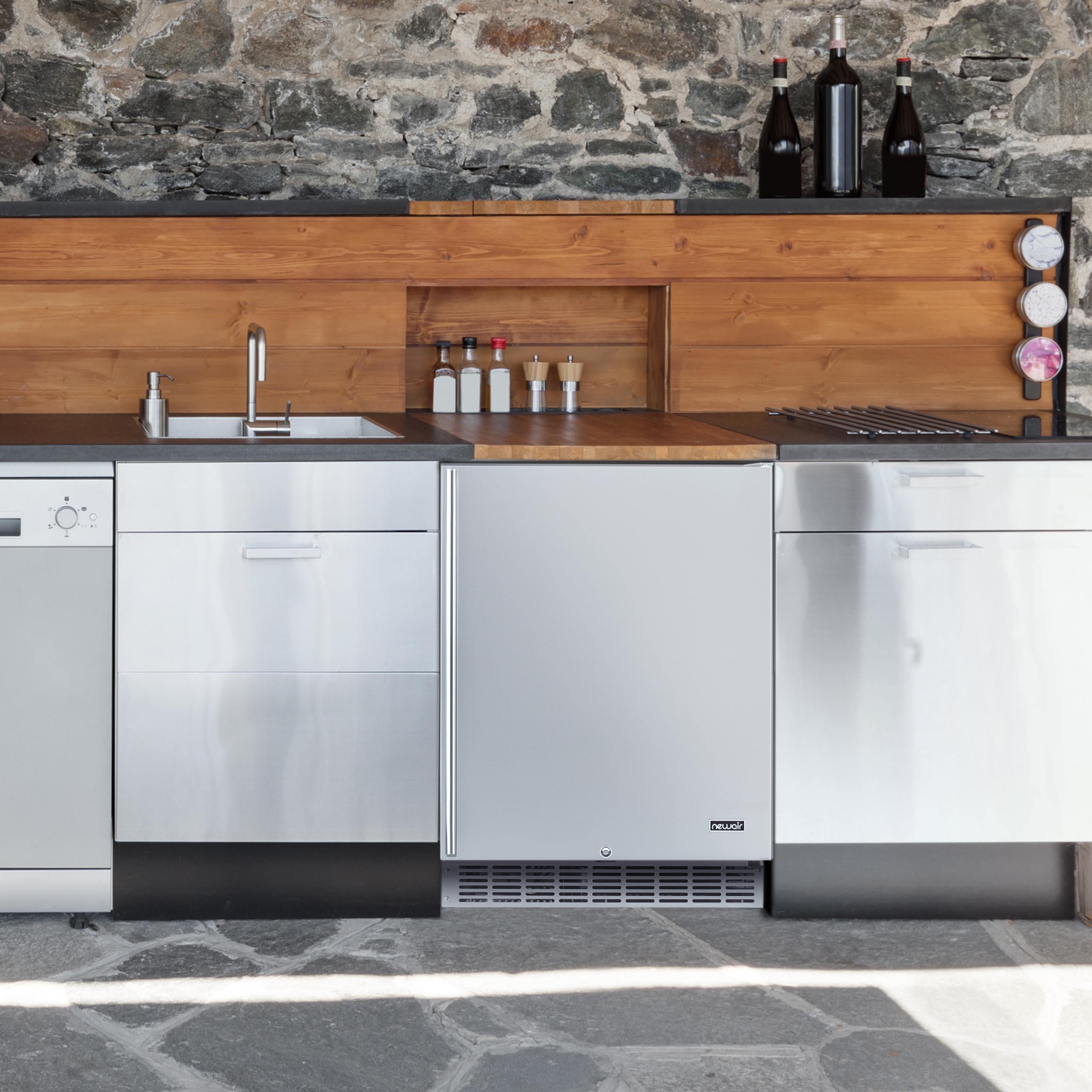Does a Mini-Fridge Use a Lot of Electricity?
Maybe you’ve seen home-makeover shows where the gleaming, updated kitchen includes a stainless steel mini fridge under the counter. Or maybe you went to a co-worker’s house for a barbecue, and envied the ease with which he could pull ice-cold beers out of a mini refrigerator that was right there in his patio. You may simply want to be ready for spontaneous guests and relaxed hospitality. A small fridge has so many uses... but electricity is expensive, and you want to do your part to conserve energy. In hot weather, you already notice your kitchen refrigerator running a lot. So is it really OK to consider adding a mini-fridge?
Mini Fridges Save Electricity
In fact, a small fridge can actually lower your energy use if you’re in the habit of opening your big kitchen refrigerator a lot just to grab the next cold drink. A mini-fridge loses a lot less cold air than your kitchen fridge every time you open it, because it is so small. A mini-fridge that can store 90 cans is only 2.2 cubic feet in volume. Compare that with a standard kitchen refrigerator: Frigidaire refrigerators range from 18 to 27 cubic feet., with the average home having one that’s 22 to 25 cubic feet in voIume. Imagine opening that 25 cubic foot fridge every time you want to grab a soda, and you can see how a mini fridge is so much more energy efficient.
Scrambling for Space in Your Kitchen Refrigerator
Even if you have a 25 cubic foot fridge, you know how easily it fills up. Just trying to find room for a few cans of beer or soda can be like solving a Rubik’s cube. You may have to distribute the cans in individual little nooks and crannies, where they will promptly be hidden under tubs of leftover potato salad and stacks of take-out containers.
What happens when friends drop over? You find the three or four cans of beer you’ve had chilling in your big fridge, and then run to the garage to grab more room temperature beers to quickly chill. You just hope these will be cold enough to drink by the time they’re wanted. If you’re feeling really pressed, you may even put a few cans in the freezer and try to remember to get them out before they explode. This hunting, grabbing and replacing routine uses a lot of electricity.
It’s Energy Efficient to Store Many Drinks at Once
With a compact refrigerator, on the other hand, you can immediately reach for the can or bottle you want. The glass fridge doors mean that you already know where everything is. If your thirsty friend downs a soda in 5 minutes and looks at you expectantly, you don’t have to run to the kitchen to get the next can. And you’re free of the stress of watching how fast your guests are finishing their beers, and trying to figure out when the next batch of cans will be cold enough to serve. NewAir’s smallest mini fridge holds 90 cans, while the largest holds 177 cans or 92 beer bottles. You’ll never have to worry about running out of cold drinks again. Furthermore, you won’t have to use any ice cubes in your soda, if you keep it at 34 degrees F. External condenser coils work together with an evaporator and a compressor in every one of our mini-fridges, providing big cooling power in a small package.
Understanding Refrigerator Energy Consumption
It’s impossible to predict exactly how much energy a fridge uses, because these appliances don’t use energy on a constant basis. Instead, they cycle on and off. They run more when they are opened frequently, or when warm items are placed inside them, or when they are set on their coldest setting. Furthermore, the amount of insulation they have is also part of the picture. NewAir’s small fridges have double-paned doors and triple-layer insulation.The more protected a fridge interior is from the surrounding environment, the less energy is needed to maintain 34 or 36 degrees, or whatever is your preferred temperature for cold drinks.
However, some fridges definitely offer more energy-efficiency than others, and you can get a clear sense of their electricity usage if you know what the various numbers mean.
Watts and Kilowatts
Let’s start with watts. Many fridges (including NewAir) list the number of watts they use when they are running. NewAir mini fridges use from 85 to 100 watts, depending on their size. Smaller fridges don’t cycle on and off as often as larger ones do.
We’ll use an example in which a NewAir fridge runs for 1/3 of the 24 hour day. That’s 8 hours. If it uses 85 watts for 8 hours, we multiply those two numbers together to get watt-hours. 85 watts times 8 hours is 680 watt-hours in a day.
The next step is converting watt-hours into kilowatt hours (kWh). All residential power consumption is measured in kilowatt hours, and that’s how your utility company charges you.
To turn watt hours into kWh, you just move the decimal point three places to the left. So 680 watt hours is .680 kWh.
Quickly Calculate Your Energy Cost
Electrical utilities charge by the kilowatt hour. You can find out your electricity rates by looking at your electricity bill or by contacting your electrical company. Most electric companies have tiered pricing. This means that electricity is cheaper if you use less of it. The electric company sets a certain standard power consumption level for a residence, and then it charges you its lowest price per kWh up to that level. If you use more electricity than the baseline level, your price per kWh goes up.
As an example, the baseline residential electricity rate in San Diego in 2018 is about 27 cents per kWh in summer, and 23 cents per kWh in winter. The next higher price tier is 47 cents per kWh in summer and 40 cents per kWh in winter. This is higher than the national average of 13 cents; this chart from the U.S. Energy Information Administration gives you an idea of relative costs for electricity across the country. If you live in a region with high utility bills, that’s another great reason to consider a small refrigerator.
Looking at Kilowatt-Hours per Year
Many appliances list their annual power consumption (in kWh per year) on their energy guide labels or in their owner’s manual. The Energy Star ratings also use kWh / year as their standard for energy efficiency.
As we mentioned above, this figure is never exact because it depends on the temperature of the room, and what temperature setting you use, and how often you open the door. It can also depend on how full the fridge is, because refrigerators use less energy when they’re full of cold food. However, despite its variability, that kWh figure is a good standard figure to use for energy efficiency. It’s also a handy way for you to figure out your operating costs for any appliance, whether it’s an air conditioner, a heater or a mini fridge.
It’s easy to estimate out how many kWh in a year your mini-fridge consumes. You simply multiply its daily usage kWh usage by 365 days. In our example above, for the 85-watt NewAir mini-fridge, we said that the daily energy usage was .680 kWh. If you multiply .680 times 365, the result is 248 kWh per year. If we use the average cost of electricity in the U.S., which is 13 cents per kWh, and multiply 248 by $0.13, we get $32. That’s your fridge cost for a whole year of ice-cold beer and soda!
A typical Frigidaire full-sized refrigerator uses 673 kWh per year, and large ones show a usage of 784 kWh per year. However, older refrigerators are considerably less efficient: This chart shows how an older fridge, from 1996, uses 1800 kWh per year. Full-size refrigerators may run their compressors 80 to 90 percent of the time, although of course this is affected by how hot the surrounding room is, how often the door is opened, and whether warm items are being put into it. In general, compact fridges run 30 to 50 percent of the time.
Shopping for a Mini-Fridge
When you’re shopping for a small size fridge for your dorm room or home office, it’s worth checking the Energy Star ratings. Consumer Reports is also a good source of information about which mini-fridges offer the most energy savings. While some people might just look for the cheapest possible mini-fridge or car fridge on Amazon or eBay, they may be shocked by the electricity cost that results. There are many brands out there, including Danby, Galanz, Heier, and more -- but we know that when you examine the energy usage details, you’ll be impressed with NewAir’s lineup of small refrigerators.




Thank you. I really appreciate your blog because I was finding this solution about mini fridge all over the internet from so many days
harry on
Ron on